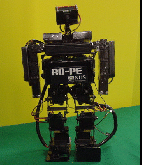| RO-PE IV Fact File |
|
- Comissioned July 2005
- Originally designed and constructed by Mr Samuel Mui
- Programmed by Mr Feng Kai
- Modifications by Mr Liang Shuang
- Reliable and robust
- First prototype of microcontroller |
|
Status
- Active
Achievements |
|

|
|
- 4th overall at RoboCup'05 Osaka, Japan
- 3rd top scorer with 10 goals in competition
- Finals of Penalty Kick event
- Semis of 2 v 2 event

- 2nd overall at Hurosot category in Fira'05 Singapore
|
?
|
|
RO-PE IV
Specifications
|
Degree Of Freedoms:
Height:
Width:
Weight:
Armor materials:
Sensors: |
22
430mm
210mm
3.3kg
Aluminium Alloy
Vision x 1 |
Control System
The control system for RO-PE IV is rather similar to earlier versions of RO-PE, which includes the computer system, sensor and actuators. |
 |
Computer Systems
One of the main differences of RO-PE IV from the previous versions of RO-PE lies in the processing unit. While RO-PE II and RO-PE III both use PC104 as their processor, RO-PE IV employs a microcontroller instead. This provides a great advantage in terms of weight and space reduction and that is why ROPE IV could still be kept to a low height of 430mm despite the two additional DOFs introduced to the body.
The microcontroller employed is ATmega128 from Atmel, which perform the primary calculations and data processing for RO-PE IV. Coupled with it is ATmega32, a less powerful but even smaller chip from Atmel, which is used mainly for PWM signals generation for RO-PE IV.
Sensors
The primary sensory system of RO-PE IV is the camera (CMUCam2) located at the head of the robot which feedback the information of the surrounding to the brain of ROPE IV for high level decision making.
The maintain heading, RO-E IV is equipped with a digital compass and communications between the chip and the compass is through a Basic stamp.
Actuators
Servos motors are used as actuators of RO-PE IV. Given the different requirements at each joint in terms of torque, weight and size, four different types of servos (from JR and Hitec) are employed, each having its advantage in either torque, weight and size. For example, small and light servos are used at the head since the load expected is only the camera and a small torque from the servos would be sufficient.
Control Algorithms
Currently, RO-PE IV operates on joint position control, where via postures are converted to joint angles by inverse kinematics offline, and then programmed onto the chip. It had tested that the current microcontroller is capable of performing inverse kinematics online and its implementation will be one of our upcoming tasks.
Speciality
Unlike many humanoid robots which walk with relatively high lift height, RO-PE IV uses a shuffling walking gait, which is achieved by a small lift height and rapid motions. This provides the advantages of stability and smaller impact from the ground during the landing phase. Though this limits the step length to be rather small, the speed of walking is still reasonably fast given the rapid motions required in this gait.
It is inevitable that a robot sometimes falls, so to be autonomous, it has to be able to get up by itself and to continue with its task. RO-PE IV has such an ability to recover from fallen positions. |